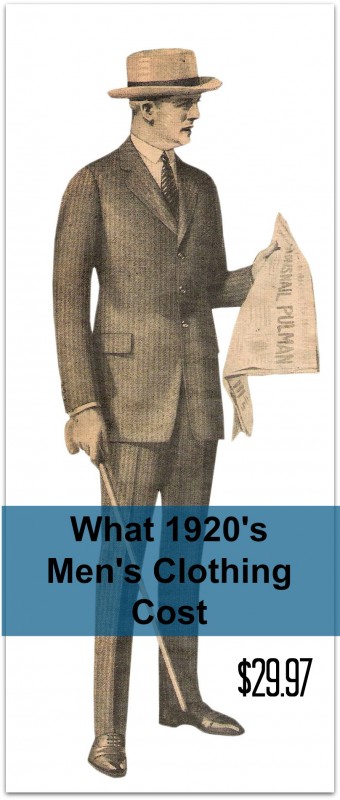
Business suit $29.75 or $413.50 in today’s USA currency
What did 1920s men’s clothing cost? The cost of men’s 1920s clothing was higher than the average woman’s wardrobe, but was also made of sturdier materials and lasted longer. A suit worn once or twice a week would last 3 years with good care. Also, men were more likely to have shoes repaired and hats reshaped, although these were tasks done by local tradesmen so they incurred additional costs. Most men’s clothing was purchased locally.
Although catalogs carried some staples such as shirts and undergarments, men preferred to shop where suits were tailored to them. In the case of rural residents without local tailors, traveling salesmen sold suits door to door, took measurements, and shipped completed clothing to them. In a family unit, it was quite normal for a man’s wardrobe budget to exceed the rest of his household.
1920s Men’s Clothing Plan
Here is a typical middle-class men’s 1920s clothing plan. Depending on his profession, he would either need business suits or work trousers/overalls suitable for his trade. The first amount is pricing in 1924 and the second is today’s estimated cost in 2013.
- 1 Felt hat $1 = $13 (Homburg, Carlsbad, Fedora)
- 1 Straw hat $1 = $13 (Boater, Panama, Fedora)
- 1 Cap $3 = $41 (Newsboy or Flat Cap)
- 1 Overcoat $6 = $78 or sheep lined moleskin jacket $16 = $208
- 1 Raincoat $3 = $41
- 1 Pullover sweater $4 = $52
- 1 Tuxedo suit $10 = $130
- 3 Business suits $3 = $41 OR 2 pairs work pants $3= $41 / 2 Pairs overalls $2.50 = $32.50 / 6 Work Shirts $9= $117
- 1 Black tuxedo vest $6 = $78
- 1 Pair flannel trousers $3 = $41 (Grey or light colors for summer)
- 1 Pair dress shoes $4 = $52
- 2 Pairs business shoes $1 = $13
- 1 Pair house slippers (leather) $5 = $65
- 1 Dress shirt $3 = $41
- 8 Shirts with collar attached $1 = $13
- 4 Pairs black rayon socks $2 = $26, Silk $5= $65
- 6 Pairs black lisle socks $1 = $13
- 4 Undershirts $1 = $13
- 4 Pairs shorts $1 = $13 and/or Union suits for summer and winter $2 = $26
- 1 Flannel bathrobe $8 = $104
- 4 Pairs cotton pajamas $2 = $26
- 1 Black bow tie $3 = $41
- 8 Four-in-hand ties (Neckties) $2 = $26
- 12 Cotton handkerchiefs $2 = $26
- 1 Pair gloves $2 = $26 and/or canvas work gloves $0.15 each = $26 for 6 pairs
- 1 Belt $2 = $26
- 2 Pairs suspenders $2 = $26
- 2 Pairs garters $1 = $13
- 1 Billfold $4 = $52
- The annual upkeep cost of cleaning, pressing, hat shaping and shoe repair $14 = $182
- Annual grooming (haircuts, toiletries) $15 = $195
See more wardrobe examples like this.
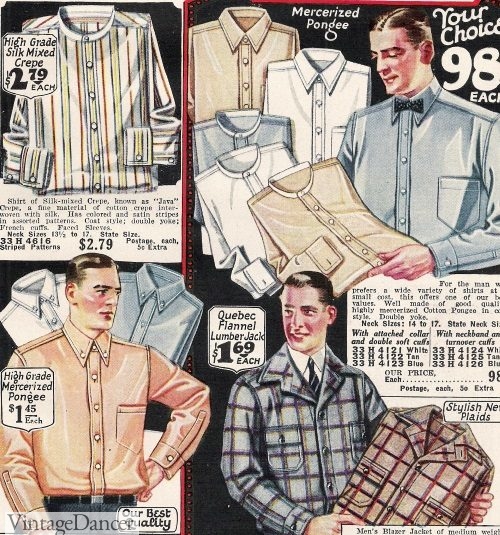
1927 men’s dress shirts- pastels, stripes, plaid
Men’s Fashion Advice
The following is an excerpt from The Correct Thing; A Guide Book of Etiquette for Young Men by William Oliver Stevens. I always find it both educational and amusing to read vintage etiquette books.
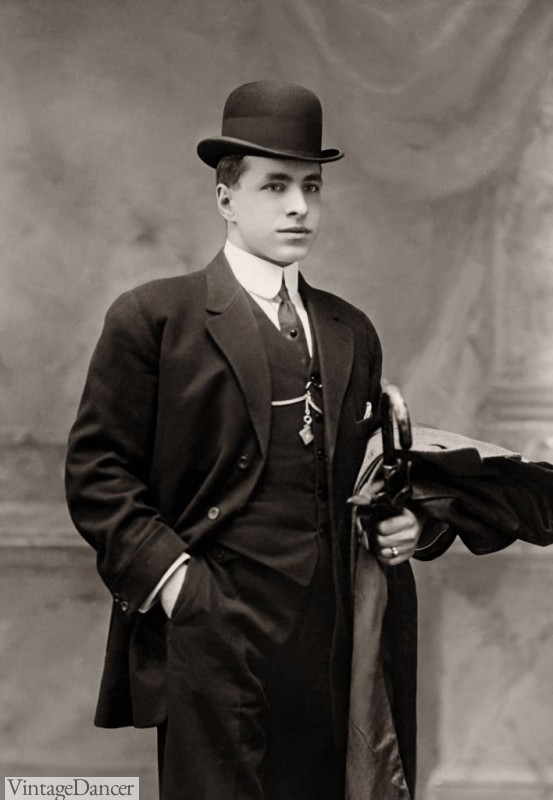
Well Dressed Young Man with Dark Suit and Bower Hat
The impression one makes upon others is dependent very largely upon one’s appearance, especially that important first impression. While we cannot all be six-footer Apollos, we can make the most of our physical equipment by taking thought as to how we look. Therefore, make sure your appearance is an asset, not a liability.
The guiding principle regarding the choice of clothes is simply that they should conform to the conventions as to what is appropriate for each occasion. Thus, the golf knickers and flannels, that are appropriate in the country or on the campus, look conspicuous in the city. The abbreviated costume worn in a track meet is not tolerated on the tennis court. Every sport has its own dress. Don’t be one of those who try to look like Tarzan.
At any haberdasher’s one can obtain sets of rules as to “what the well dressed man will wear.” But the young man of pre-college or college years need not worry about a cutaway coat or full dress. For him, a dark business suit is sufficient for all daylight purposes— church, calls, afternoon receptions, and weddings—provided he does not have to function as an usher or best man. In that unhappy case, if everyone else is in full dress, he has to under go the entire misery and expense of cutaway, top hat, striped trousers, patent leathers, and gloves.
For all evening affairs the dinner coat, or “Tuxedo,” is sufficient for the youth of student age. Of course, if he wants to put on the extra swank, the tail coat and white tie combination are still more formal. With the dinner coat it is permissible to wear a white waist- coat, but never a white tie. Plain black dress shoes may be substituted for patent leathers. With a dinner coat one may wear almost any kind of hat—opera hat, derby, dark felt, or in the summer a straw hat.
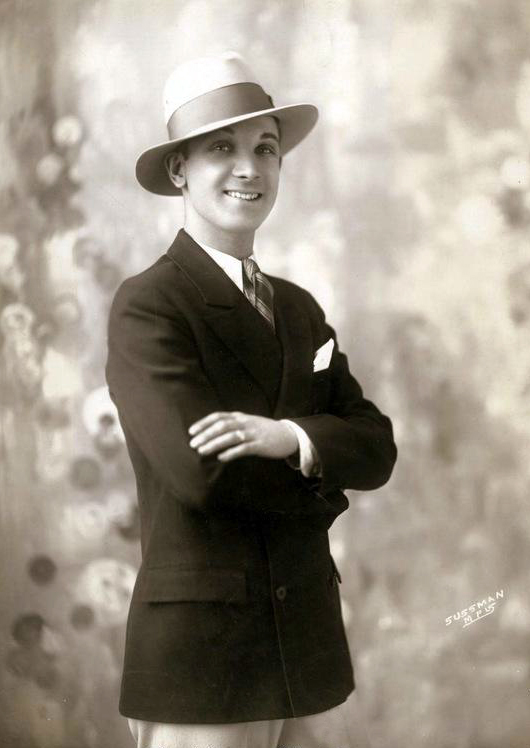
Young Man in Blue Blazer, White Duck Trousers, and Straw Hat. Summer Ivy League look.
For summer parties and dinners, what is called “summer formal” has become the fashion. This is a business coat (and sometimes waistcoat) worn with white soft shirt and white or striped flannels and white or black- and-white shoes and white socks. As a matter of fact, this costume is hotter than the Tuxedo, but it seems to convey the impression of summery clothing.
Of course, in matters of dress, styles are constantly changing. In general, wear what the occasion and the place demand. In matters of detail not defined by custom, use taste. For example, don’t go about in shirt sleeves or suspenders. Don’t leave your collar off. Don’t wear a sweater to the table.
Cleanliness and Tidiness Do’s and Don’t
- Take a good soapy shower every day.
- Keep your teeth clean.
- Keep your nails clean and trimmed. Don’t waste money on a manicurist. You can leave the flashing fingernails to the man who wears a large diamond scarf pin.
- Shave often enough to keep your face look- ing clean. Nothing ruins a man’s appearance more than sprouting bristles.
- Be sure your collar is clean.
- Keep your shoes shined.
- Don’t wear a shirt more than two days at most.
- Don’t wear a tie that is soiled or frayed.
- Keep your hair trimmed. Shagginess is for animals and second rate musicians.
- Keep your hair brushed.
- Keep fingers out of ears and nostrils.
- Keep your hands off your face.
- Keep your clothes brushed, sponged, and pressed. Put your coat and trousers on a hanger every time that you take them off. Care in this regard will save the tailor’s bills. Soap and a nail brush will clean off many a spot on your suit.
- Always start out with a clean handkerchief.
- Sometimes it is well to carry a spare. Be sure that the ornamental one in your breast pocket is immaculate.
- Don’t wear socks with holes. Don’t let socks drape over your ankles.
- Shoe trees are inexpensive. They will save the shape of your footgear.
- Don’t think that because dirt isn’t seen that it needn’t be washed away. If you wear a sweater a good deal, don’t forget to send it to the laundry. Because a sweater is dark and doesn’t show the dirt is no reason for concluding that it isn’t dirty.
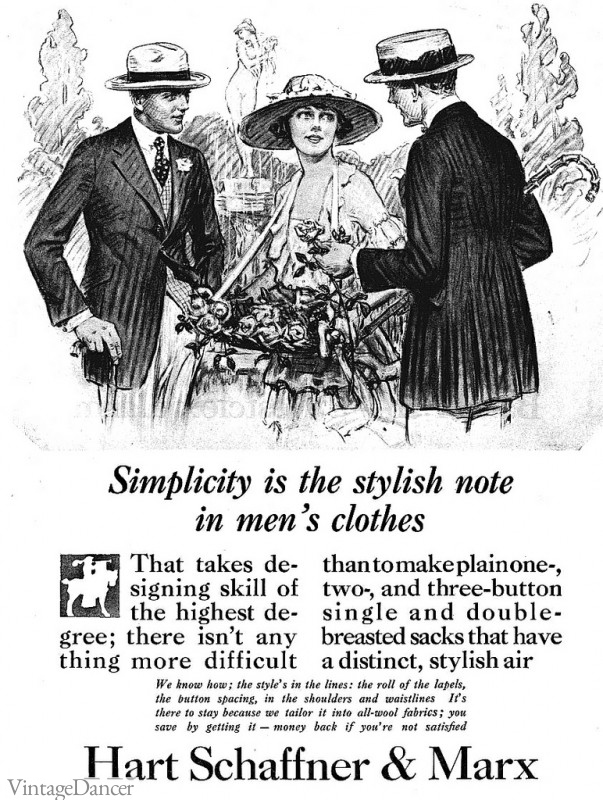
Simplicity is the stylish note in men’s clothes
Debbie Sessions has been teaching fashion history and helping people dress for vintage themed events since 2009. She has turned a hobby into VintageDancer.com with hundreds of well researched articles and hand picked links to vintage inspired clothing online. She aims to make dressing accurately (or not) an affordable option for all. Oh, and she dances too.